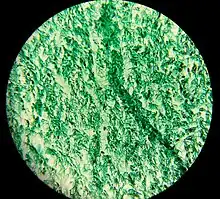
Wharton's jelly (substantia gelatinea funiculi umbilicalis) is a gelatinous substance within the umbilical cord,[1] largely made up of mucopolysaccharides (hyaluronic acid and chondroitin sulfate). It acts as a mucous connective tissue containing some fibroblasts and macrophages, and is derived from extra-embryonic mesoderm of the connecting stalk.
Umbilical cord occlusion
As a mucous connective tissue, it is rich in proteoglycans, and protects and insulates umbilical blood vessels.[2] Wharton's jelly, when exposed to temperature changes, collapses structures within the umbilical cord and thus provides a physiological clamping of the cord, typically three minutes after birth.
Stem cells
Cells in Wharton's jelly express several stem cell genes, including telomerase. They can be extracted, cultured, and induced to differentiate into mature cell types such as neurons.[3] Wharton's jelly is therefore a potential source of adult stem cells, often collected from cord blood.[4] Wharton's jelly-derived mesenchymal stem cells may have immunomodulatory effect on lymphocytes.[5] Wharton's jelly tissue transplantation has shown to be able to reduce traumatic brain injury in rats.[6]
Etymology
It is named for the English physician and anatomist Thomas Wharton (1614–1673) who first described it in his publication Adenographia, or "The Description of the Glands of the Entire Body", first published in 1656.[7]
Isolation of stem cells protocol
After obtaining the umbilical cord from the donor, it is transported to the laboratory in a cold and sterile environment using a transfer buffer that contains phosphate buffered saline (PBS). Subsequently, the vessels should be eliminated from the umbilical cord tissue on a sterile plate with the aid of autoclaved scissors. The sections of the umbilical cord tissue that are devoid of arteries should then be fragmented into smaller fragments. These tissue fragments are subsequently placed in a sterile cell culture plate or cell culture flask, and the cell culture medium (enriched with fetal bovine serum and antibiotics) is added. Lastly, the flask containing the tissue fragments is placed in a CO2 incubator for a duration of 1-2 weeks. This process ultimately leads to the proliferation and migration of stem cells from the Wharton's jelly into the plate or flask.[8]
References
- ↑ Wharton's jelly in the Merriam-Webster Medical Dictionary.
- ↑ Sadler, T (2010). Langman's Medical Embryology (11th ed.). Wolters Kluwer. p. 105. ISBN 9780781790697.
- ↑ Mitchell, Kathy E.; Weiss, Mark L.; Mitchell, Brianna M.; et al. (January 2003). "Matrix Cells from Wharton's Jelly Form Neurons and Glia". Stem Cells. 21 (1): 50–60. doi:10.1634/stemcells.21-1-50. ISSN 1066-5099. PMID 12529551. S2CID 14596922.
- ↑ "Wharton's Jelly, Hair Follicles New Sources of Adult Stem Cells, Studies Find". 13 May 2005. Archived from the original on 17 November 2006. Retrieved 20 November 2008.
- ↑ Zhou C, Yang B, Tian Y, Jiao H, Zheng W, Wang J, Guan F (September 29, 2011). "Immunomodulatory effect of human umbilical cord Wharton's jelly-derived mesenchymal stem cells on lymphocytes". Cell Immunol. 272 (1): 33–8. doi:10.1016/j.cellimm.2011.09.010. PMC 3235326. PMID 22004796.
- ↑ Cheng T, Yang B, Li D, Ma S, Tian Y, Qu R, Zhang W, Zhang Y, Hu K, Guan F, Wang J (February 1, 2015). "Wharton's Jelly Transplantation Improves Neurologic Function in a Rat Model of Traumatic Brain Injury". Cell. Mol. Neurobiol. 35 (5): 641–9. doi:10.1007/s10571-015-0159-9. PMC 4481175. PMID 25638565.
- ↑ Warton T (1656). Adenographia: sive glandularum totius corporis descriptio. London: Wharton. pp. 243–44.
- ↑ Ahangari, Fatemeh; Mirsanei, Zahra; Soudi, Sara; Khaligh, Sahar Ghaffari; Soufi, Sara; Hashemi, Seyed Mahmoud (2023-10-03). "Isolation of Mesenchymal Stem Cells (MSCs) from Wharton's Jelly (WJ) Tissue of Human Umbilical Cord (hUC); a Protocol". School of Medicine Students' Journal. 5. doi:10.22037/smsj.v5.42169. ISSN 2676-7597.